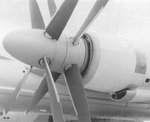Bruce R.
Recruit
"Aircraft which have counter-rotating propellers rotating toward the cockpit on the top side (such as the Beechcraft Duchess) do not have a critical engine, while both engines are critical on aircraft with counter-rotating propellers turning away from the cockpit.
The Lockheed P-38 was an example of the latter."
All I can say is that the above exerpt came from the article that you sited.
The Lockheed P-38 was an example of the latter."
All I can say is that the above exerpt came from the article that you sited.



